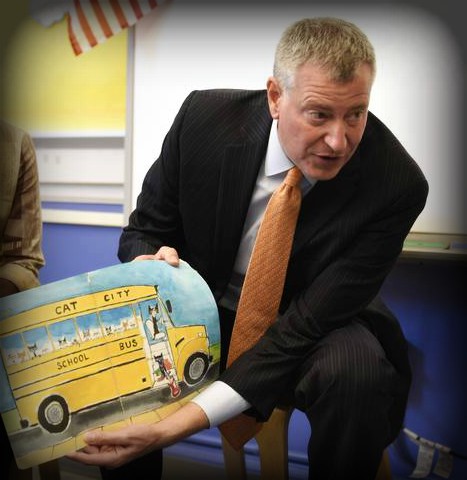 Inequality in New York City schools have been the focal point of intense debate. Mayor Bill de Blasio is considering scrapping the Specialized High School Admissions Test (SHSAT), an SAT-esque examination that allows the highest scorers access to New York’s 8 elite high schools [1]. Many groups, parents, and alumni, particularly Asian-American groups, have expressed outrage at the potential measure because they feel the system will be diluted with less deserving students. Asian-American students make up over 50% of the elite high school system, creating calls for diversity and animus toward standardized tests as a method for determining intelligence.
Inequality in New York City schools have been the focal point of intense debate. Mayor Bill de Blasio is considering scrapping the Specialized High School Admissions Test (SHSAT), an SAT-esque examination that allows the highest scorers access to New York’s 8 elite high schools [1]. Many groups, parents, and alumni, particularly Asian-American groups, have expressed outrage at the potential measure because they feel the system will be diluted with less deserving students. Asian-American students make up over 50% of the elite high school system, creating calls for diversity and animus toward standardized tests as a method for determining intelligence.
The controversy around the potential SHSAT repeal is a conversation of socioeconomic status rather than race. Most U.S. school districts rely on local property taxes to fund schools which can lead to maldistributed resources due to fluctuations in household income and net worth as you cross district lines. New York City is a special case due to an extensive academic hierarchy and emphasis on standardized testing. Many students’ futures become tethered to formal examinations before even beginning middle school. Do students who consistently produce higher scores do so because they are gifted?… Or because their parents could afford extracurricular tutoring?
In March 2014 the Civil Rights Project, operating out of the University of California, Los Angeles, or UCLA, released an in-depth report depicting New York City as having the most segregated school system in the country [2]. The report induced a wake-up call to top administrators that greater consideration must be taken to diversify the system’s more promising facilities. New York’s public schools run on the doctrine of school choice, though empirical evidence has shown that when given a choice parents will flock to higher performing schools, ones lacking in diversity amongst the student body [3]. Compounded with increasing gentrification, and academic barriers to entry like SHSAT and the labyrinth-esque nature of the NYC school system, make access to a quality education difficult for low-income students.
Defenders of the SHSAT and the existing placement system argue that the students being placed into the system have earned their place through rigorous study and commitment to education. Juxtaposed with the feelings of SHSAT detractors who feel that they lack the resources to adequately prepare their children for the daunting exam. The vendetta here is that of aptitude vs. affluence.
Why You Should Care:
The New York City school system is the largest in the nation and some might say the most complex. Typically parents would just enroll their children into a school that is an acceptable distance away and fits the appropriate age range, ‘admission’ was a word saved for after high school. However, in New York admission begins in middle school with parents scrambling to prepare their children for the hyper-competitive system starting from 5th grade.
NYC middle schools admit students on a vast array of criteria from report cards to attendance records [4], with higher performing schools stratified to the wealthier areas of the city. Parents who are financially capable often hire counselors and firms to track deadlines, organize binders of records and extracurricular work, and prepare applications. Working and middle-class parents have to rely on online bulletins and the limited amount of school counselors that are available and hope that their child gets a seat. High school is even more competitive with most parents vying to send their children to schools that outperform their district of residence, creating a massive influx of applications to a select few seats leaving many students and parents disillusioned and underserved. Anyone who has done even a modicum of research into higher education knows that the high school you attend can carry great weight on a college admissions application. Per example, a student with a 3.5 Grade Point Average from a challenging high school is far more attractive than a 3.8 from a low performing one. The paramount importance of secondary education has polarized the population:
SHSAT supporters believe:
- System promotes meritocracy
- Removing test will dilute schools
- Schools will suffer academically
- Will disincentivize hard work
SHSAT opponents posit:
- System promotes aristocracy
- Diversity will improve campus composition
- Upward social mobility will help minorities
- More low-income students will have access to quality education
When UCLA released its initial report the city unveiled a“diversity plan” [5] which called for more admissions transparency and establishing ethnic quotas on certain student bodies. If passed, the test will be discontinued and student admission to the top high schools will be based on middle school grades, state examinations, and various criteria in order to create a more ‘holistic’ process. This system is flawed because grades and standardized test scores may fall into the same socioeconomic stratification as the SHSAT and give more admissions control to these schools may serve to worsen the lack of diversity.
Resolution:
. NYC schools should use their resources to establish a testing support unit to allow low-income students to have similar access to test preparation as more well of students.
Metrics to measure academic capability are inherently complex and often prove to be unreliable, however, standardized exams can create a level playing field if all other factors are equal. Additionally, specialized support should have a similar income threshold such as the free or reduced lunch price system to ensure that resources have a progressive effect on the student body. Next, the New York Department of education should make its system less intimidating and drop words like ‘admission’ when not referring to college. They should also make an appoint increase per-student spending in lower income areas to reduce competition.
Given the myriad of factors that a student can be assessed on standardized testing as a good strategy to differentiate between candidates and give everyone a fair chance to compete. But this competition can never be fair if some receive a head start or additional help along the way. Equal access is the only way to preserve a truly meritocratic education system, one where placement is solely dependent on scholastic aptitude and not familial affluence.
Take action:
Do you believe the SHSAT should remain? Sign up here- https://change.org/p/carl-heastie-keep-shsat-as-the-sole-specialized-high-school-admissions-criterion
Want to see better preparation for the SHSAT? Track and support this bill- https://nysenate.gov/legislation/bills/2017/s8212
Want a more in-depth examination of NYC inequality? Sample this article- https://civilrightsproject.ucla.edu/research/k-12-education/integration-and-diversity/ny-norflet-report-placeholder/Kucsera-New-York-Extreme-Segregation-2014.pdf
Want a guide to the specialized high school system? Read this handbook- http://schools.nyc.gov/NR/rdonlyres/39E5EC65-FA08-4A2A-91AD-9F7334670B3D/0/20172018SpecializedHighSchoolsStudentHandbookENGLISH.pdf
References:
- “Blasio Proposal Slammed” Spectrum News NY 1, accessed June 26, 2018. http://ny1.com/nyc/all-boroughs/news/2018/06/05/nyc-parents-alumni-asian-american-groups-slam-bill-de-blasio-push-to-scrap-shsat
- “New York’s Extreme School Segregation: Inequality, Inaction, and a Damaged Future”, The Civil Rights Project, accessed June 26, 2018. https://civilrightsproject.ucla.edu/research/k-12-education/integration-and-diversity/ny-norflet-report-placeholder
- “New York’s Separate and Unequal Schools”, The Nation, accessed June 26, 2018. https://thenation.com/article/new-yorks-separate-and-unequal-schools/
- “Middle Schools”, Inside Schools, accessed June 26, 2018. https://insideschools.org/middle/how-to-apply
- “Country’s largest segregated school system-” Chalk Beat, accessed June 26, 2018. https://chalkbeat.org/posts/ny/2017/06/06/the-countrys-largest-school-system-and-one-of-the-most-segregated-just-released-its-school-diversity-plan-here-are-the-highlights/



